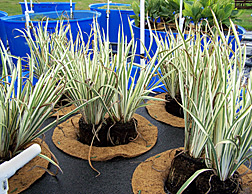This page has been archived and is being provided for reference purposes only. The page is no longer being updated, and therefore, links on the page may be invalid.
Read the magazine story to find out more. |
|
|
Floating Vegetative Mats May Help Clean Fishery Wastewater
By Sharon DurhamJanuary 29, 2009
The feasibility of using floating vegetation to remove nutrients from fishery wastewater is being tested by Agricultural Research Service (ARS) scientists.
The researchers' long-term goal is to develop a system to treat the wastewater, return it to ponds for reuse, and use the nutrients to produce biomass or plant material. The floating mats act as filters to remove the nutrients from the water.
The study participants are soil scientist Robert K. Hubbard at the ARS Southeast Watershed Research Laboratory, in Tifton, Ga.; plant geneticist William Anderson and plant pathologist Jeffrey P. Wilson at the ARS Crop Genetics and Breeding Research Unit, both in Tifton; and University of Georgia animal science associate professors Gary Burtle and Larry Newton, also in Tifton.
Wastewater from the fish-production ponds is pumped into 340-gallon aquaculture tanks. Each tank has a 10-foot-square floating mat on which the vegetation grows.
The first objective is to find plant species that grow well in fishery wastewater. Twelve different plant species are currently being tested: St. Augustine grass, Tifton 85 bermudagrass, common bermudagrass, canna lilies, iris, bamboo, bulrush, cattail, bordergrass, napiergrass, reeds, and maidencane. According to Hubbard, the iris is the best performer so far.
The second part of the study--set to begin in the spring of 2009--will determine the effects of the vegetation on water quality and the amount of nutrients removed when plant biomass is harvested.
The plant material will be harvested on an as-needed basis and the plant tissue analyzed for nitrogen, phosphorus, and potassium. Harvested plant material has several potential uses: It can be transplanted, used as feedstock for energy production, or composted and used as a soil amendment.
Read more about this research in the January 2009 issue of Agricultural Research magazine.
ARS is the principal intramural scientific research agency in the U.S. Department of Agriculture.

